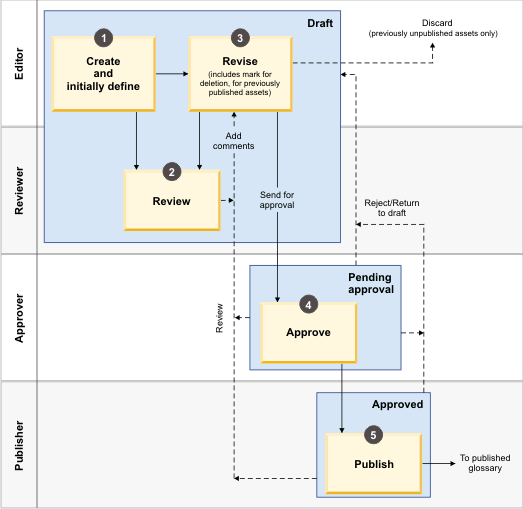Workflow process
The Information Governance Catalog Glossary Administrator defines and assigns the appropriate workflow roles to users.
After the changes to glossary assets have been reviewed and approved, those glossary assets are published to the catalog. All IBM® InfoSphere® Information Governance Catalog users can view the catalog, even those users who do not have workflow roles. The specific content that each user can view is determined by catalog permissions.
For example, if a new term, "Calculated" is added to the category "Risk" in the development glossary, Information Governance Catalog Basic Users and Information Governance Catalog Users cannot see the term "Calculated" until the Publisher publishes this new term. In addition, a user who is a Information Governance Catalog Glossary Author but who does not have permission to access the category "Risk" in the development glossary also cannot see the new term until it is published. However, a user who is a Information Governance Catalog Glossary Author who has been given development glossary permission to the category "Risk" can see the new term before it is published, but only in the development glossary.
After "Calculated" has been added to the catalog, the author of this term decides that it should have the database table "DB2_Fiscal_YTD" assigned to it. The author edits "Calculated" and assigns DB2_Fiscal_YTD" to it. When a user views "Calculated" in the catalog, the user can see this assignment, even though the term "Calculated" has not been republished.
The following figure shows a typical workflow process. The process that you implement in your enterprise might be different in some respects. Or, you might have several different processes in place, for different subsets of the glossary.

- Step 1
- Create and initially define. An Editor creates a new glossary asset or modifies an existing asset. To effectively use the workflow feature, you need to define who is part of your governance team. Then, the Information Governance Catalog Glossary Administrator must assign the appropriate workflow roles (Editor, Reviewer, Approver, or Publisher) to the users who are part of that governance team. Users with the appropriate workflow roles modify glossary assets in the development glossary based on the workflow state (Draft, Pending approval, or Approved) of the asset.
- Step 2
- Review. Governance team members review the new or changed draft asset by viewing the details page of the asset in the development glossary. At this stage, the asset does not appear in the catalog. Typically team members with the Reviewer role review and submit comments, although any team member who has a workflow role can do so.
- Step 3
- Revise. The Editor revises the asset based on the received comments. To see all of the comments, the Editor can view the development log on the details page of the asset. The review and revise steps can occur iteratively, until all of the required governance team members agree that the asset is ready to be published. After completing the revisions to the asset, the Editor sends it for approval. When you send the asset for approval, the state of the asset changes from draft to pending approval.
- Step 4
- Approve. A governance team member with the Approver role either approves the asset for publishing or rejects it. After the Approver has approved the asset, the asset is in approved state. If an approver rejects the asset, it returns to the draft state and the authors and reviewers can revise it further. An approver can also send an asset that is in the approved state back to the draft state.
- Step 5
- Publish. Once the asset is approved, a governance team member with the Publisher role can publish it. After the asset is published, it is displayed in the catalog. An identical copy of the asset is retained in the development glossary, ready for future revision.
From the details page of an asset in the development glossary, you can perform development activities with the asset according to your workflow role. For example, if you are an Approver, you can approve the asset for publication. However, if you are an Editor, you can edit the details page, but you cannot approve the asset.
Comments about assets can be added to the development log at any time, regardless of their workflow state.
If the workflow feature is enabled, a user who is an Approver must approve changes to the content, and a Publisher must explicitly publish the changed content before it can be seen by InfoSphere Information Governance Catalog users who do not have a workflow role.
The video in this link, Video showing workflow features, describes the workflow process. Click this link and run the video to see the workflow process.